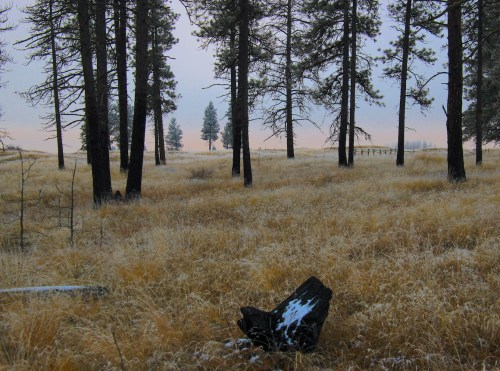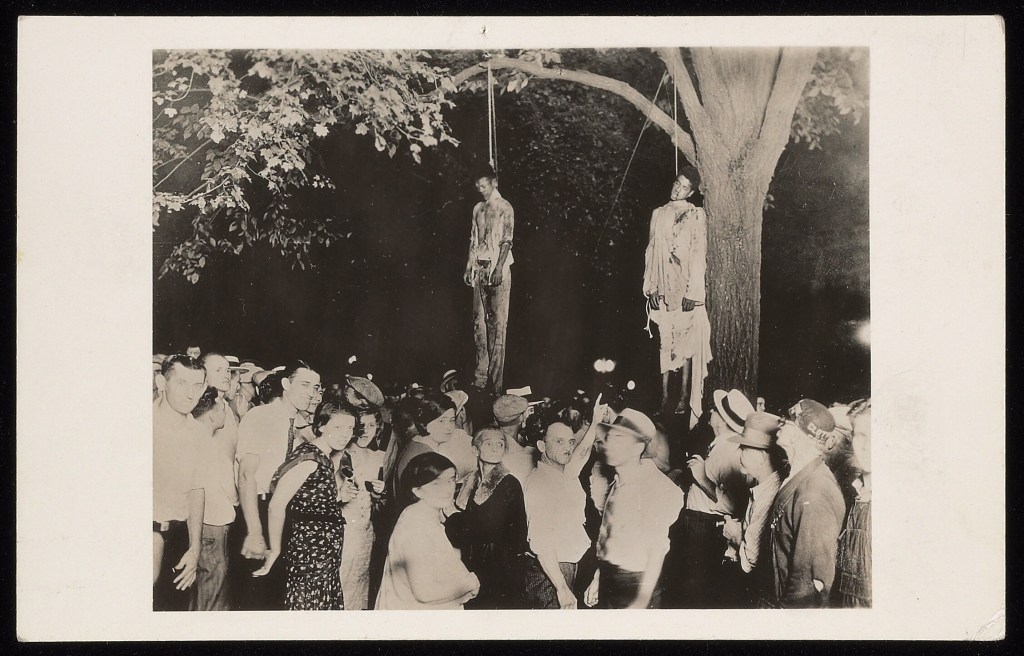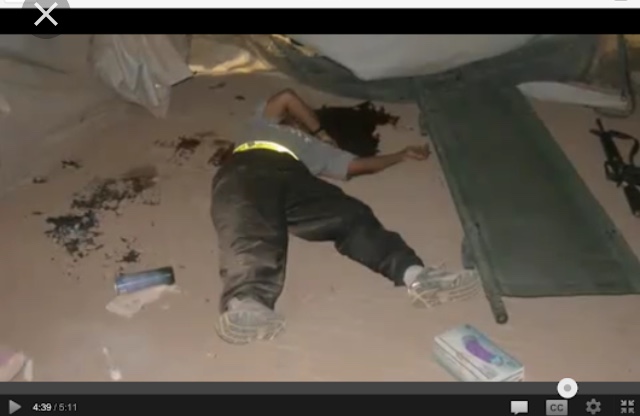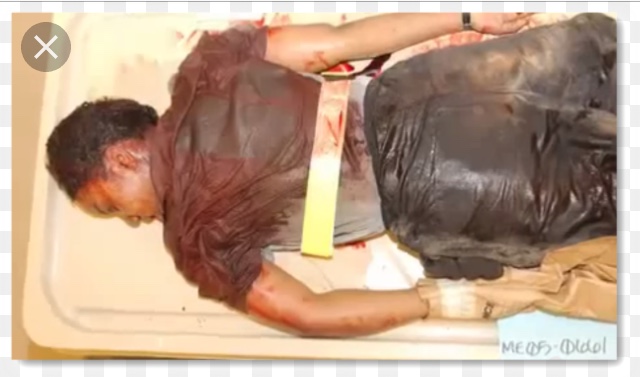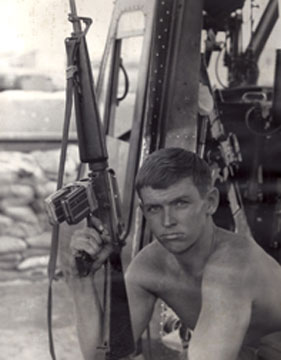“F BOMB” WARNING
Note: The following story quotes a young former Marine using the F word in describing his military experience. If the word offends you please stop reading now. I include the word’s use because the most obscene thing I know is war. Rage, note psychology authorities, is the normal emotion of those who have been to war. Rage is a “core emotion,” essential to human survival; that’s why babies exhibit it. Enraged by war’s obscenity, military folk often resort to the F word to convey their torment. The first book in the Western literature canon, The Iliad, is about war. “Rage” is the book’s first word. A friend of mine who identifies as a devout Christian once saw the “F Bomb”—that’s what he called it—in something I wrote about war and urged that I remove it lest I go to hell. That’s a big discussion, but I told him that I thought removing it would sanitize the truth and go along with the devil’s best trick of convincing the world he doesn’t exist. I respect Jesus, and I happen to believe that had he written about Vietnam, as I have, he might have used the F Bomb, as I have, to name a demon. And had someone threatened him with hell for telling the evil truth about war he might have said: “Satan, get behind me.” Anyhow, read on or not as you wish.

Nick Jeffries, left, with Ryan Sill in Fallujah.
“Badass Marine” is how Nick Jeffries describes himself during his four-year enlistment, 2003-2007. He went in right out of high school with a brain—modern neuroscience shows this—seven years away from being biologically capable of adult discernment. (That’s what “infant-try” means.)
I asked him why he went in. Patriotism?
“I wanted to shoot people,” he said.
He doesn’t seem like that kind of guy. Not now, anyway. I’ve seen him with his two kids. From what I can tell, anyone would love to have him for a dad.
“Really?” I said.
“Well, I wanted to get in gun fights,” he said.
He wanted the action, for sure, to kill bad guys for freedom. I once wanted the same thing.
Nick had two tours in Iraq, in Al Anbar Province, a drab and searing place of brain-wrecking concussion and sudden, bloody, incinerating, vaporizing meat grinder death. He served in the 3rd Battalion of the 5th Marine Regiment, 1st Marine Division—3/5. Lima was his company. Call sign: Havoc. Battalion call sign: Dark Horse.
First tour Nick was a mere FNG grunt, a new guy with a profane adjective in front of “new.” He carried a Squad Automatic Weapon, a SAW, M-249, which is a light machine gun capable of firing up to a thousand rounds a minute. He won meritorious promotion to the corporal rank of E-4 in a scant one year seven months.

From left, Cpl. Sill, Cpl. Jeffries, unknown.
Exactly one year later, for his second deployment, he was meritoriously promoted again, to E-5 sergeant. Badass.
Second tour Sgt. Jeffries was a squad leader and carried an M-16 A4.
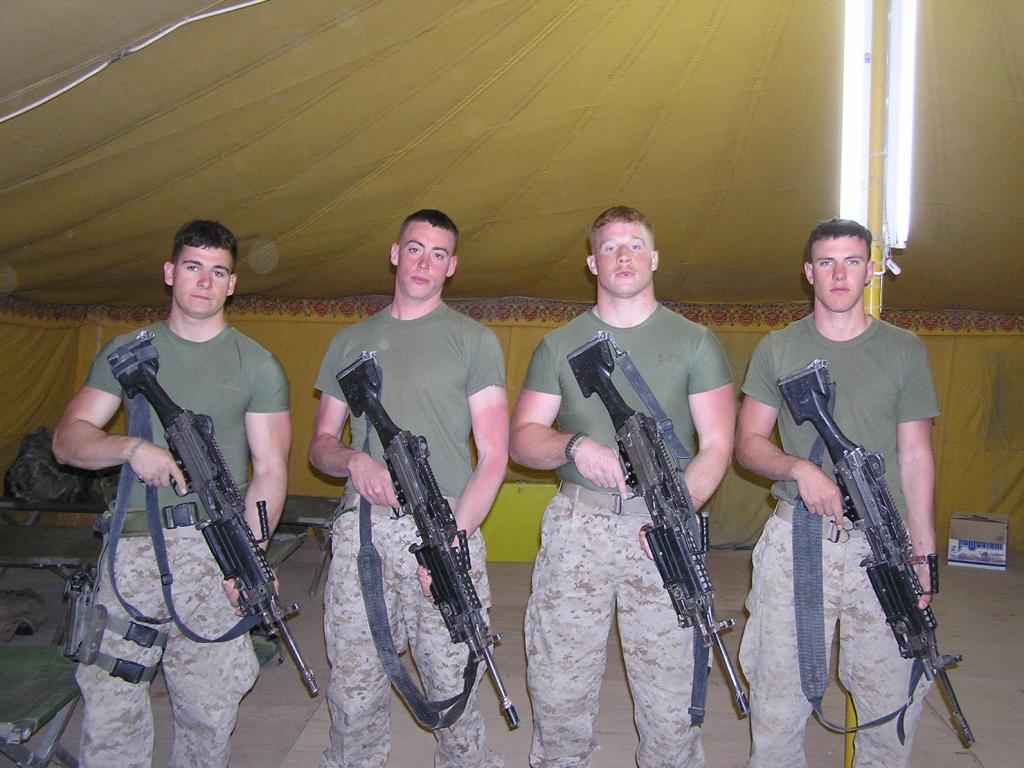
From left, Nick Jeffries, Nick Schrader, Mica McConnell, Peter Sewell.
Nick was in the really bad stuff in Fallujah. Operation Phantom Fury. That means the first actual offensive that scattered the three hundred thousand inhabitants into what the poet Shelley called the “lone and level sands,” turning Fallujah into a ghost town.
Then he was in the second push. Nick and his Marines were sent to “back clear” Fallujah of the “enemies” who had returned or snuck through lines.
“Our mission,” he told me “was to destroy the city so no one will want to come back. That was a general’s orders.” My notes record the future tense—“no one will want to come back”—as though the objective was to create a piece of forever hell.
“We did whatever we wanted. If they’re in the city they’re combatants. (This present tense Dr. Edward Tick, a PTSD expert, calls “frozen war consciousness.” I know it well.) We smashed, broke and burned. This isn’t talked about. I didn’t think or feel. I was a really good Marine.”
(In Vietnam, we had “free fire zones.”)
Nick was at that Euphrates River bridge where the charred, mutilated bodies of the ambushed Blackwater employees were hung. Nick was exposed to more “big booms” than he can count. “I was buildings-away from two-thousand pounders we called in. One was so close it collapsed the walls of the building we were in.” That’s the time he heard the “steel mosquito,” a bullet whizzing by his head. (See description below.)
Nick and his buddies once had the famed late Navy SEAL sniper Chris Kyle and his partner attached to their unit. In an elegant house the Marines occupied above the Euphrates near the Blackwater bridge, Nick says that either Kyle or his partner remarked, “I wish I could be a fucking Marine. You guys can do whatever the fuck you want.”
That’s Kyle’s weapon in the photo below.
The left-handed SEAL compliment echos Eleanor Roosevelt: “The Marines I have seen around the world have the cleanest bodies, the filthiest minds, the highest morale, and the lowest morals of any group of animals I have ever seen,” she once said. “Thank God for the United States Marine Corps!”

Kasey Kinley photo
During his 14 months in Iraq Nick Jeffries took life and he saw life taken. Sgt. Jeffries collected tiny pieces of American viscera for burial. He almost died more times than he can count. He saw the lifeless bodies of innocent Iraqi children.
“That’s the part of war that fucks you up.”
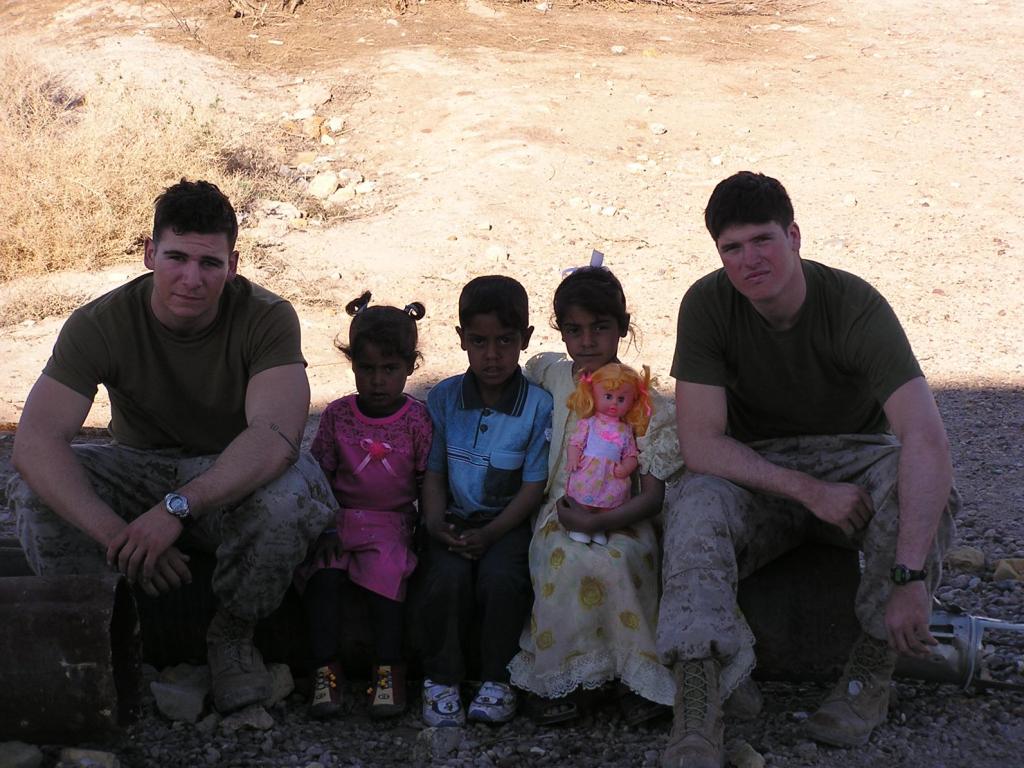
Nick, left, and Kasey Kinley with Iraqi children they went to help. Kasey Kinley photo.
The VA rates Nick 80% disabled from the post-traumatic stress disorder (PTSD) he brought home from war. VA allocates 10% of his benefits for the ringing in his ears left by war’s noise, 70% for war’s psychological trauma, and 10% for his headaches from the traumatic brain injury sustained from countless explosions. In VA math, that adds up to 80%.
But even though sleeplessness is one of the most diagnostic symptoms of PTSD, according to Dr. Jonathan Shay, former VA psychiatrist and one of the world’s leading PTSD authorities, VA denies that Nick’s sleeplessness has anything to do with what happened to him in war. That Nick has to use a CPAP (Continuous Positive Airway Pressure) machine so he won’t stop breathing and die in his sleep, has nothing to do with the war that we sent him to, says the VA.
Nick’s been in psychotherapy for all of the 10 years since he left the Marines. He became what he calls a “gym rat,” pumping iron so furiously that his body exploded and people suspected him of using anabolic steroids. “I don’t, you dipshit,” he would tell them. Instead, he milked his cells for the better drug of endorphins. To get the endorphin hit that Nick does you just have to carry the memories of Fallujah. “I could talk about a different incident every day that nobody’s heard of,” he told me.
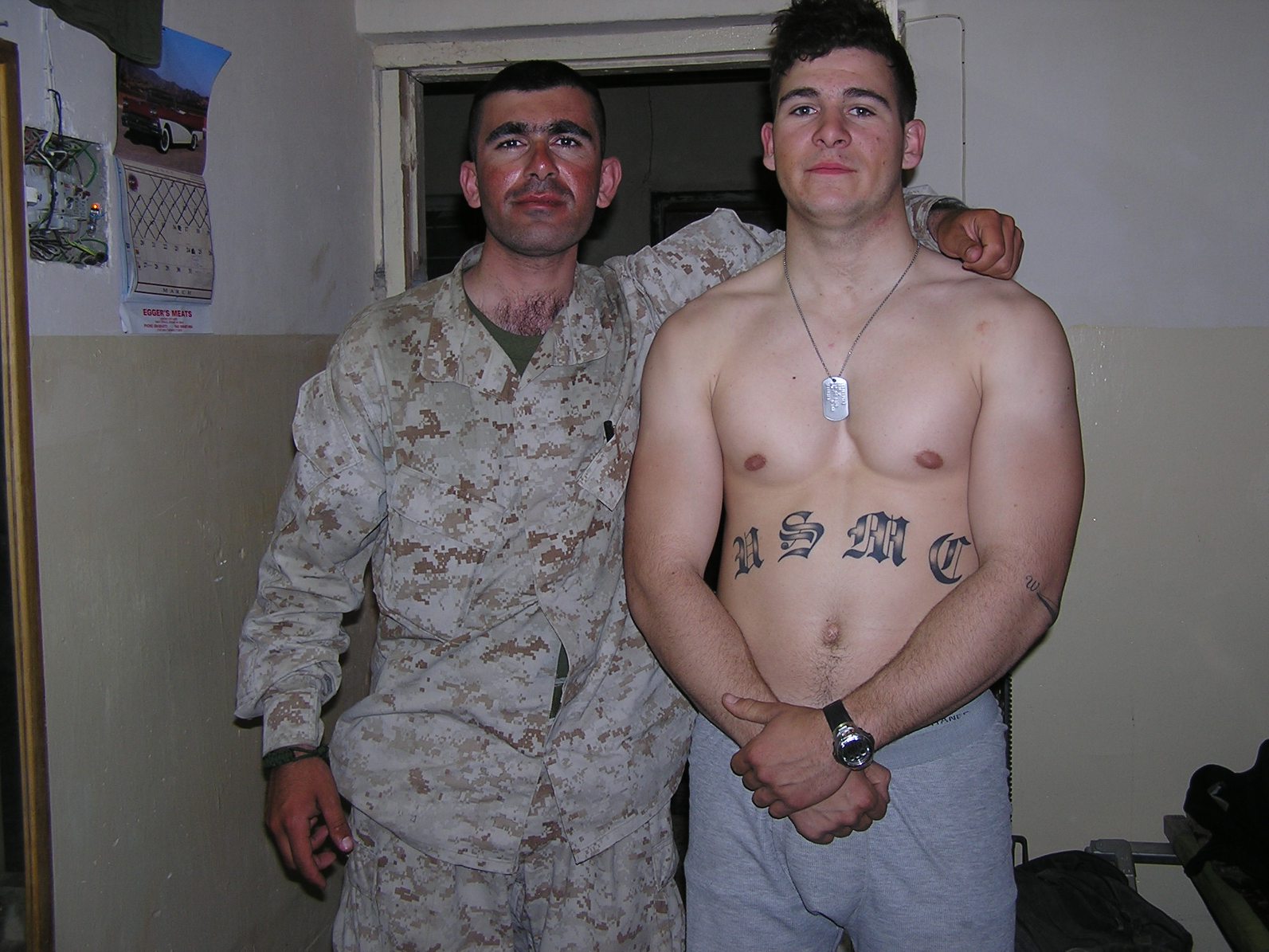
Nick and Iraqi interpreter.
Nick does take the VA’s anti-depressant drugs. He has done Cognitive Behavioral Therapy, and he does Eye Movement Desensitization Reprocessing therapy. Light, however, is what works best for him. The light of the wilderness. The one light that Eden saw play.
The light involves hunting. “Hunting is the only place I don’t have anxiety. The woods are my release. It’s a natural Zen.”
The breath of the trees, the majesty of the mountains, they comfort him.
“I hunt excessively,” he says. “Elk piss is my favorite smell. Elk is my favorite meat.”
He hunts big game 35-40 days a year, starting with bows in September, then rifles—modern and black powder—and he hunts until Christmas day.
“I can’t sit home if I have an elk tag. I’ve considered quitting a job in order to hunt. I’ve taken leaves of absence without pay to hunt. I’ve spent a thousand dollars on tags. I would sell three of my fingers to hunt.”
His daughter London was five or six when she scolded him: “Dad, you go from hunting season to shed season to fire season.”
Only the thrill of the chase gives him the adrenaline fix he needs to soothe his PTSD. Except when hunting, “I’m so numb I don’t know where I am.”
Anxiety ambushes him all the time. Why? God only knows.
The first time I met Nick four straight days of anxiety had ended just the day before. What’s it feel like?
“Like an anvil’s on my chest. It makes me feel like dog shit.”
Three years ago—it had happened many times before—Nick’s PTSD nearly did him in; he ended up in a VA inpatient program in Seattle.
Nick has a degree in Environmental Studies from Gonzaga University and works for the Washington State Dept. of Natural Resources. He helps private landowners manage their forests for health and fire prevention. He also fights wildland fire, and recently retired from running inmate hand crews on wild fires.
Fighting these infernos, of course, is notoriously dangerous and kills people all the time. But it’s mundane for Nick, devoid of adrenaline. He’s a sawyer, fells standing burned out trees, one of the most dangerous jobs in the woods. “Let Jeffries do it,” his colleagues will joke when a particularly lethal tree needs to come down. Nick will lay down a towering charred giant held up by two fingers of wood right where it needs to go. Only the deadliest of trees can give him a shot of adrenaline.
The problem is, that meager adrenaline drip doesn’t offset the misery that heat causes him because of his time in Iraq.
As soon as Nick got out of the Marines he tried sky diving for his adrenaline fix. Nothing. After Fallujah only hunting dependably triggers his adrenals and gives him this strange cosmic peace that surpasses understanding.
The wilderness light worker in Nick began unexpectedly six months after his Marine Corps discharge. Driving through Priest River, ID, on their way to Sandpoint, Nick and his wife passed Robby Kucherry selling antler lights from the back of his pickup. A $250 Kucherry creation changed Nick’s life. In Sandpoint Nick told his wife he wanted to withdraw the money to buy Robby’s antler lamp. Nick was a new college student and it was a lot of money but his wife agreed. Nick bought it on the way back home to Spokane and, mesmerized, he began hunting and buying antler “sheds” himself. He sold his first antler lamp within a year of leaving the Marines.
Since then, he has transformed himself into a Michelangelo of antler lighting fixtures. All kinds: table lamps, floor lamps, chandeliers that resemble wild galaxies made of Whitetail, Blacktail, Mulie and Fallow deer, Shiras, Canadian and Alaskan moose, Roosevelt and Rocky Mountain elk, Barren Ground caribou, antelope, reindeer.
Nick can barely keep up with the demand for his art. He has a ton of antler inventory in his shop that he’s purchased just this year. So far this year he’s done at least 10 chandeliers, 40 lamps and countless other antler art creations. He’s half the age of most antler artisans.
After hunting, working in his shop with antlers is his safe place. “It allows me to relax,” he says, “and turn off my brain and just be. I can really turn off negative thoughts working with antlers. And I tend to have a lot of those.”

Antler Man.
Like many of us with PTSD, Nick tends to keep to himself. “I have a heavy disconnect,” he says. “I have few friends.” Awful loneliness comes from such isolation, but somehow the need for safety—to avoid stressful social settings and relationships—dictates it. I know this only too well. Still, ten years after Nick met him, “Robby Kucherry and his family are friends to this day,” evidence that the heaviness of our disconnect doesn’t eliminate our need to connect.
Now 33, the still-young man who says he went into the Marines at 18 because “I wanted to shoot people” lives with the intensified disconnect of a changed mind. “I don’t know if I can define what I do and don’t believe,” he says. “I wouldn’t make a good Marine now. I didn’t think when I was a Marine. I did what they told me. Now I think. Today, I’d tell them all to fuck off.”
For one thing, he says, “Do you really even believe in your enemy?” He tells of a three-man Syrian rocket team that was firing at his platoon’s forward operating base. Nick killed one of them himself, buddies another. One apparently survived.
“I feel like most of the time we had such an overwhelming firepower.”
The Syrian Nick killed was maybe jobless and hopeless in his homeland, Nick speculates, “and someone offers him $500 to go to Iraq and kill American Marines. I’d have been down with that, too.”
His words remind me of something a friend of mine told me. He was a B-52 bombardier in Vietnam. “I did it for the money,” he gruffly tells those who make the mistake of thanking him for his service. And then he’ll cry, this burly stud. The tears seem to hurt him worse than physical pain.
Many veterans share this embarrassment of tears. Nick experienced it a few years ago at a supermarket when an Iraqi family was checking out behind him.
“I was in Iraq,” Nick told the kids.
“Iraq bad. Boom, boom,” said one of the kids.
Recognizing the lack of what the family had on the conveyor belt, Nick took a $100 bill from his wallet and handed it to the woman, whose head was covered with a scarf.
Then he ran from the store sobbing.
Why? God only knows.
War leaves us with incomprehensible grief that society sees as mental disturbance. Our agony, I think, comes from knowing we belong to a species that falls so far short of its potential.
We struggle with our PTSD alone, mostly, because telling the truth about this injury that is the most common military wound makes it hard to recruit a few good men and women. The problem with the Marines’ slogan is that it covers up the depth of the goodness of men like Nick Jeffries, the truth that we are too well and fearfully made to kill with a clear conscience. For most men—me included—crying in public is more embarrassing than incontinence.
Many times in my professional career during a business meeting something would trigger a Vietnam flashback. I’d excuse myself like I had diarrhea, rush to a men’s room, close the stall door, and cry my guts out. I’d be wearing one of my expensive Southwick suits and starched dress shirt and expensive tie and shoes, camouflage to make me blend in, clothing that served the same intended purpose as the 40-pound chicken plate that I stuffed under my flack vest when I flew in the helicopter gunships. My sobbing might be as violent as projectile vomiting. Then I’d wash my face with cold water and go back to work.
“Do you really even believe in your enemy?”
These are words that come to some of us with age. Nick’s lucky they’ve come to him so young, creating the mother of all psychological conflict. Blessedly, there is no cure for PTSD—we’d be doomed otherwise. But a rich vein of personal growth lies buried in it—the kind of treasure Helen Keller found in her blindness—if you can find the wherewithal to mine it.
To discover that vein of growth you have to answer the enemy question for yourself. But here’s my advice: don’t try it unless you’re ready to forgive yourself. Not sure? Get help.
The pandemic human insanity that keeps us from recognizing the single blessed reality that connects us all to all that is, the crazy illusion that there is an “other” against whom we must wage war, should be “at the center of theological reflection on social realities,” argues theologian Miroslav Volf. (The italics are his.)
Didn’t Pogo say that? “We have met the enemy and he is us.”
But such thoughtfulness isn’t what warriors come home to. Nick, like me before him, like my WW II Marine father before me, like all antebellum fathers throughout history, found that a mad world sends us to the madness of war. The madness changes all of us in different ways. Then the world brings us back—it’s not home anymore—and demands we rejoin its insane cult.
And the world calls our struggle a disorder.
My own beloved father could never talk to me about his experience in the Pacific—except to tell me once, before his eyes glazed over, that he’d seen flamethrowers used. “It’s just hard to believe human beings can treat each other that way,” he said. He committed suicide a few years ago as an old man.
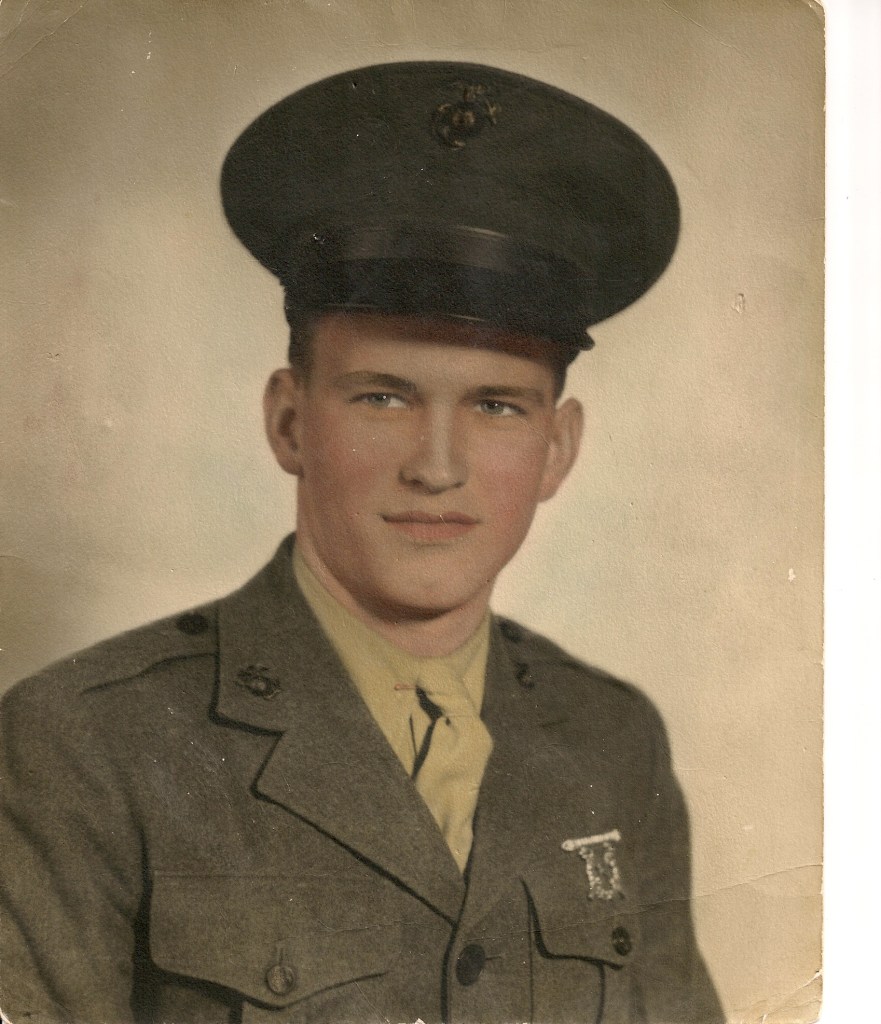
My father as a 17-year-old Marine.
When you get right down to it, all the well-meaning thank-you-for-your-service celebration of war expects us to go along with the lie that war is good and that our complicity makes us good, too.
Really? Some 58,000 of my brethren were killed in the Vietnam War. A reliable estimate is that about 300,000 of us have committed suicide so far. What that means is that war is a deadly foe that stalks you all of your life.
The young go to war because elders send them. Elders tell them it’s right. Later, we’re vulnerable to this haunting inner voice. Kill yourself, it hisses.
The World War One British officer and poet Siegfried Sassoon, and contemporary former Marine platoon commander David J. Morris, call this The Evil Hours that subject veterans to damaged mental health, to “the sweating suffocation of nightmare.” Former Marine Gen. Smedley D. Butler, one of the most decorated Marines in history, labeled it the racket of war. The Marine Corps boasts that it is “always faithful,” but in the searing documentary Thank You For Your Service former Marine and retired Navy Cmdr. Mark Russell calls the Corps’ neglect of Marines’ mental health “betrayal.”
What Sassoon said of his WWI generation could be said of all generations: “In the name of civilization these soldiers had been martyred, and it remained for civilization to prove that the their martyrdom wasn’t a dirty swindle.”
Marines can get shot for treason if they betray their country. What do you call it when the Marine Corps betrays Marines and their families?
“I wouldn’t make a good Marine now… Today, I’d tell them all to fuck off,” Nick tells me. “I have a heavy disconnect.”
Roger the disconnect, I want to tell him. It’s Ariadne’s Thread. It’s what led you to the antlers, the wild song that lures you into the eternal sanity of the hills. Keep following it. I think it’s the only thing that can lead you out of the PTSD labyrinth.
There’s a clue in William Stafford’s poem, “A Ritual to Read to Each Other.”
“If you don’t know the kind of person I am and I don’t know the kind of person you are a pattern that others made may prevail in the world and following the wrong god home we may miss our star…”
I can offer Nick and all my younger military siblings the advice to read and think about Stafford’s poem, and to seek their own home star, because war turned me into the same kind of person they are: a lost and wounded animal.
I saw Nick’s antler lamps in the display window of Carr Sales in downtown Spokane, 919 W. 1st Ave. (Check it out. The Carr folks are old-fashioned nice.) I’ve always loved antler art, but Nick’s pieces radiated strange power. They stopped me in my tracks and pulled me inside.
They were so beautiful with their sweeping runic bone lines that invoked a lost language. Their birch-bark lampshades seemed eternal. The lamps glowed rapturous peace, like wind in the trees, like the hymn of streams.
When I learned that their artisan was a Marine veteran of Iraq and that his lamps were therapy for his PTSD I had to have them. Knowing the broken heart that produced this art, relishing its testimony to the heart’s self-mending power, I bought them on the spot and brought them home.

Nick’s table lamps and the old woman I sleep with, 17-year-old Tinkerbell.
They instantly filled my little base camp with wonderful calm. They speak to me in a wordless language of a glorious place where there would never be call signs like Havoc or Dark Horse. Instead, were they needed at all, the call signs of this once and future country would be Fear Not, All Is Well, words like that.
I bought more of Nick’s lamps for their medicinal value to me. I got to know Nick, sat and visited with him in his shop as he worked on a massive chandelier, and felt such pride in him and gratitude for his saving art.
“I’m experiencing progressive betterment,” he says. “I’m still here. I’m still successful.”
That’s a very big deal, because like so many of our brethren he could have fallen at his own hand.
I wrote most of this on July 4, 2018. It turned out to be the best 4th of July I’ve ever had. It started at 1:30 in the morning when my PTSD woke me. I made myself an Appletini with an ounce-and-a-half of vodka to turn off my brain—like saying to a dentist: “Sure, I’ll take the Novocain.” I sat in my chair reading The Hidden Life of Trees with its proof of the hidden magic surrounding us, living warp and woof of the world.
And I found myself resting my hand on Nick’s antler floor lamp beside me. It was like holding God’s hand. I don’t know why.
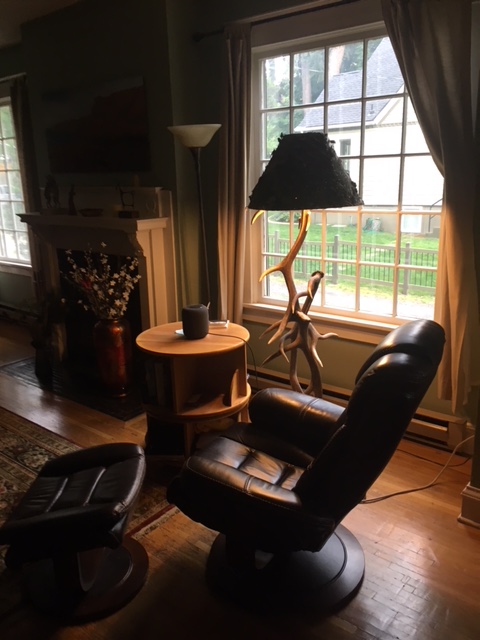
Suddenly, I was flooded with the sense of belonging and connection that mostly, painfully, eludes me these days. I felt connected to my tribe, all the warriors of history that civilization has sacrificed in the name of civilization. All day on the Fourth I was alone and writing about all this. But that made me not alone. I was at peace with my brothers, whom I love as no other. I was as deeply happy as I’ve ever been. I was connected beyond my disconnection with our crazy world.
I commend the message of Nick’s soul repair to you—his magnificent art, too—because of the urgency of our shared need for it. That Nick labors in light of the living world against the darkness of PTSD I find more poetic than William Stafford’s poem.
Invoking circus elephants to make its point, Stafford’s poem ends:
And as elephants parade holding each elephant’s tail, but if one wanders the circus won’t find the park, I call it cruel and maybe the root of all cruelty to know what occurs but not recognize the fact.
And so I appeal to a voice, to something shadowy, a remote important region in all who talk: Though we could fool each other, we should consider—lest the parade of our mutual life get lost in the dark.
For it is important that awake people be awake, or a breaking line may discourage them back to sleep; the signals we give—yes or no, or maybe—should be clear: the darkness around us is deep.
See Nick Jeffries’s work at Carr Sales, or contact him at Instagram: njeffries0311, or nicholas.jeffries@yahoo.com.
The Steel Mosquito.










